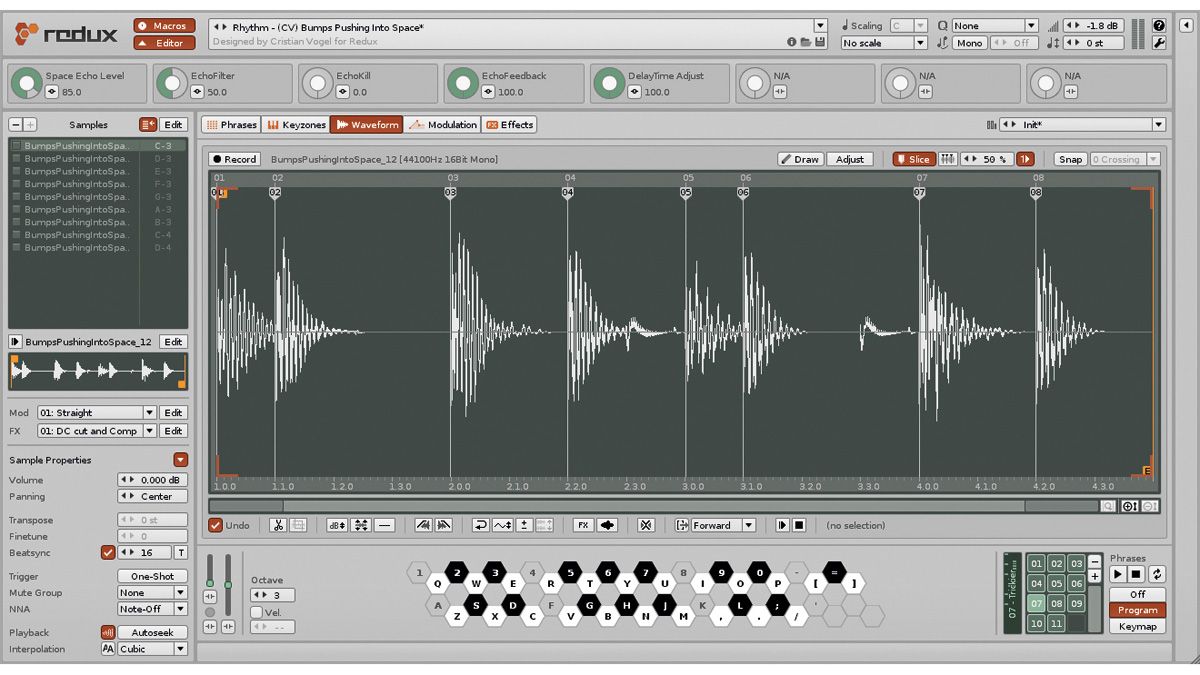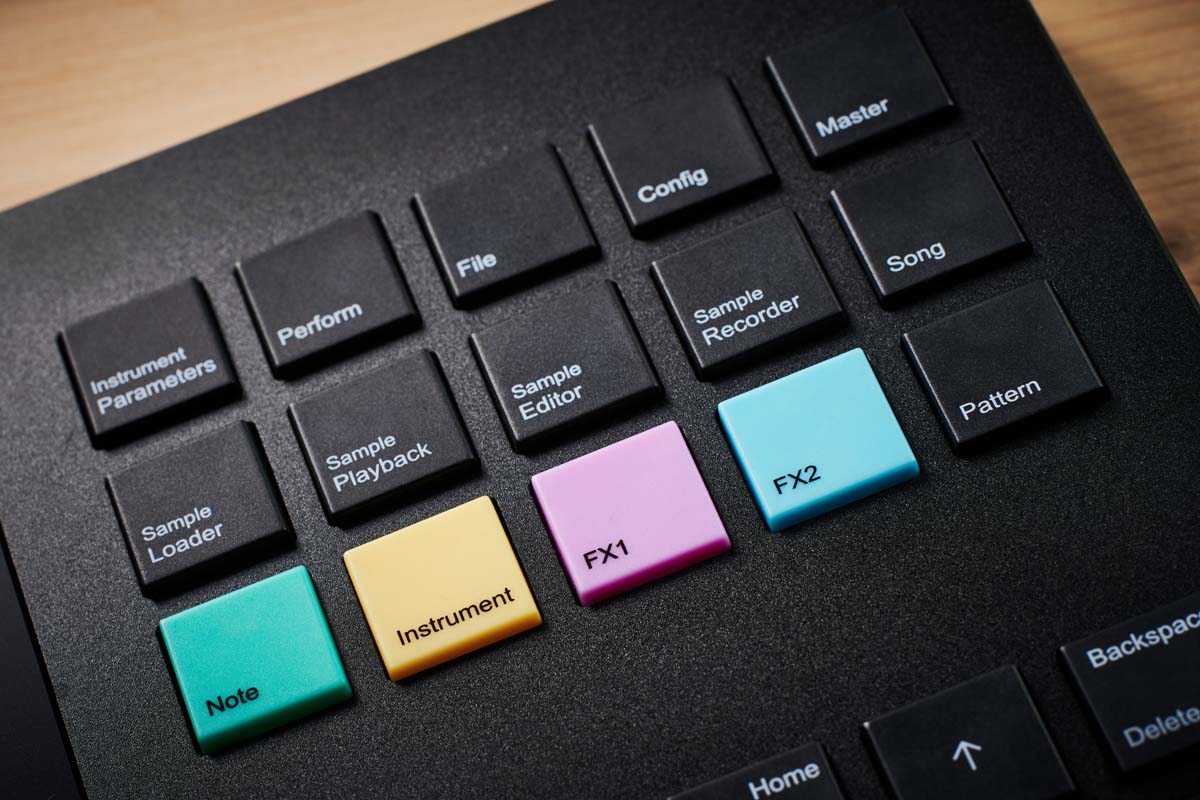MusicRadar Verdict
Less esoteric than it first appears, this is a sleek, well-designed hardware sampler that’s both fun and inspiring.
Pros
- +
Fun, creative sampling workflow.
- +
Combines classic sampling with granular and wavetable synthesis.
- +
Well priced.
- +
USB powered and portable.
Cons
- -
Setting up Instruments requires a fair amount of menu jumping.
- -
Tracker interface likely to be an acquired taste.
MusicRadar's got your back
What is it?
Ever since Ultimate Soundtracker arrived for the Amiga almost 30 years ago, trackers – the subset of music production applications that were inspired by that original piece of software – have existed as a minor, albeit influential, alternative to mainstream music production tools.
Distinctive for their vertical sequencing layout and numerical programming, trackers were originally popular as they offered a cheaper, self-contained alternative to early music software and MIDI gear.
That USP diminished somewhat as conventional software became more accessible, but trackers have maintained a cult popularity, thanks in part to their often free and open source nature, and their links to the demoscene sub culture.
They may have fallen out of favour a little in recent times, but it’s still remarkable how many of the artists Future Music interview profess to having got their first taste of music production using some form of tracker.
Was the world crying out for a hardware tracker? Probably not, to be honest, but Tracker makes a very convincing case for the concept nonetheless
With Tracker, Polish brand Polyend have taken many of the general principles shared by tracker applications and placed them into a hardware instrument.
On a workflow front, that includes the vertical sequencer and emphasis on pattern sequencing, but it’s also coupled with retro-influenced hardware that uses a pad-based ‘keyboard’ with a touch of the Commodore about it.
Was the world crying out for a hardware tracker? Probably not, to be honest, but Tracker makes a very convincing case for the concept nonetheless.
Want all the hottest music and gear news, reviews, deals, features and more, direct to your inbox? Sign up here.
So what actually is it? Retro influences aside, Tracker is essentially a multitrack hardware sampler.
Performance and verdict
Samples are either recorded or loaded to the instrument’s memory from an SD card slot, which are then used to create up to 48 ‘instruments’. There are four ways that instruments can make use of these source samples.
The first is straightforward one-shot/looped sampling, joined by a sample slicing mode, whereby loops can be cut up either by automated transient detection and adjusted by hand.
The remaining two modes allow for basic sample-based synthesis, either via wavetable or granular processing of the source sample. The adjustable wavetable window setting means Tracker can load wavetables used for your favourite plugin too.

• Renoise Redux
In bringing the essence of Renoise to your DAW, Redux opens up a new world of audio software - its tracker workflow is something you'll either love or hate, though.
• Elektron Digitakt
Tracker elements aside, Digitakt is probably the closest rival here, with its creative sample sequencing tools.
• Teenage Engineering OP-1
The OP-1 is a very different beast, but it puts an equally unique twist on hardware music making. It’s also got an FM radio onboard.
Each sample can be adjusted via an edit and playback menu, with parameters specific to each instrument type, along with a selection of destructive effects that can be baked into the source sample itself, including bitcrushing, delay, compression and modulation effects (samples are edited after being loaded into Tracker’s memory, so the original files on the SD card are unaffected).
Each instrument also has its own multimode filter, plus a modulation matrix that allows either an ADSR envelope or LFO to be applied to each volume, pan, filter cutoff and wavetable or granular position independently.
The bulk of the creative work takes place within Tracker’s Pattern view, which is the element most reminiscent of software trackers of old.
With its vertical layout and numerical programming, this could potentially look fairly daunting to those not familiar with tracker layouts, but in reality there’s little here that deviates from the logic of a common step sequencer.

Tracker’s coloured buttons make it easy to jump between editing notes, instruments and FX.

The bulky navigational rotary is the most used tool for data input and parameter editing.

The pad-based ‘keyboard’ can be mapped to scales. It also handles various input functions.

Tracker’s generously-sized screen makes navigating its unusual Pattern generator easy
Patterns are arranged across eight tracks laid out from left to right, with steps running down the screen vertically. Much like any other sequencer, pattern length and timing can be adjusted in relation to the project tempo, which dictates the rate at which Tracker moves down through the steps of each pattern.
Every step can contain four kinds of info – note, instrument, FX 1 and FX 2. The first two of these are fairly self-explanatory, setting the instrument used and the pitch at which the sample is played back.
You don’t need to buy into the whole tracker thing to enjoy this instrument
The two FX parameters, rather than dealing exclusively with effect parameters, can assign multiple types of playback conditions and parameter changes.
For instance, as well as being used to dictate volume and delay send level, the FX slots can also engage rolls, micro-timing/-tuning adjustments, reverse sample playback and set probability levels for each step.
There are a few elements of the Pattern creation workflow that might seem jarring to those not used to trackers; the need to manually input note off/fade triggers to silence an instrument, for instance, or the lack of global swing, meaning that micro-timing/tempo adjustments are required for creating looser grooves.
On the sequencing front, two of Tracker’s most interesting tools are its Step and Fill functions. The former of these is handy for speeding up the creation of repeated beat elements; you can, say, input a kick drum with a Step value of 4 to quickly duplicate it across every beat in your groove.

Fill, on the other hand, can auto-generate patterns across an assigned selection of steps, based around configurable parameters. In use it’s like a cross between a randomisation tool and an offline arpeggiator.
It’s a really fun and useful tool, my only criticism being that I’d like a few extra choices of pattern shape – as it stands Fill can input a constant stream of the same note (handy for, say, hi-hat patterns), a completely random selection of notes, or a simple rising arpeggio.
A few classic arp patterns would be a handy option. There is an Invert function though, for quickly reversing the order of selected notes. Once individual patterns have been created, Tracker lets users take things further using its Song and Perform modes. Song is a fairly straightforward arrangement tool, allowing creation of long-form compositions.
Perform mode, meanwhile, offers ‘punch-in’ versions of some of the FX available in the Pattern sequencer. Here, each effect can be assigned four presets, for quickly jumping between settings. It allows, for example, quick filtering, glitchy sample manipulation and on-the-fly transposition. The Perform view also lets users mix-and-match patterns across the eight tracks, allowing for rearranging of songs.

Given some practice and a bit of preparation, it has the potential to become a really fun live tool. There’s more to Tracker than just arranging pre-existing samples though. The hardware has both line and mic mini-jack inputs – both mono, as are all samples/tracks – that allow users to sample directly into Tracker itself.
The sampling workflow is a simple case of selecting an input, adjusting gain and monitoring and hitting record. Some kind of tempo sync’d or level-triggered recording would be nice, but on the whole the process of sampling is intuitive.
Tracker also includes a built-in FM radio to act as an additional source – a really nice touch. My one complaint is that, due to how the interface is set up, it’s not possible to sweep through radio frequencies at the same time as recording.
The final element of Tracker’s creative chain is its Master section. Here users can mute individual tracks, set the master volume and adjust a trio of effects – master bitcrush and limiter, plus a digital delay.
It’s worth noting too, that Tracker can also output MIDI via USB and minijack connections, with several pattern FX modes available for outputting CCs and program change messages directly from the sequencer, making it capable of driving external gear too.
For all that it’s unique, the capabilities of Tracker aren’t actually far removed from those of, say, Elektron’s Digitakt
Altogether, Tracker is a very capable machine with deep, interesting tools. The question is whether the tracker aspect is more than a gimmick. And, honestly, that’s debatable. On the one hand, for all that it’s unique, the capabilities of Tracker aren’t actually far removed from those of, say, Elektron’s Digitakt.
Conversely though, the tracker-style pattern grid, with its four-part method of step input can certainly be inspirational in that it forces you to think about your usual compositional traits (literally) from a different angle. You don’t need to buy into the whole tracker thing to enjoy this instrument though.
Detractors will dismiss the software tracker format as fiddly and unintuitive, but fortunately Polyend’s smart design here has done away with most of those annoyances. In reality, this is tracker-lite, not hardcore demoscene territory.
Where idiosyncrasies remain, they inspire creative workarounds rather than frustration – such as the need to use micro-timings rather than swing, or to layer monophonic sounds across multiple tracks to make chords.
Tracker is slim and USB-powered, and can run off a battery pack for a fully portable production experience
Tracker is likely an acquired taste – it took me a good few days to come around to it. While the workflow on the whole is fluid, loading samples and setting up instruments does involve jumping between a fair few menus.
Any weaknesses are outweighed by smart design choices though. I love that Tracker is slim and USB-powered, and can run off a battery pack for a fully portable production experience.
It’s able to export both pattern and song stems to the SD card too, giving a simple method for routing creations into a DAW (a feature sadly absent from a lot of modern digital hardware). At the time of writing, there are still a few features to be added (such as a lo-fi sampling mode and more effects) but Polyend have a good track record for regular updates.
Tracker is undoubtedly the best so far of Polyend’s already unique, bold range of offerings: a sleek, powerful and fun sampler that, given its sub-£500 price, has really come to win me over.
MusicRadar verdict: Less esoteric than it first appears, this is a sleek, well-designed hardware sampler that’s both fun and inspiring.
The web says
“I’ve been all about the fill function, randomly generating patterns is great, especially within restricted parameters like scale/range of samples it can pull from. I’ve practically written an entire album just experimenting with that alone.”
Sarah Longfield
“After one week with the Polyend Tracker, I feel like a teenager again. This is the authentic tracking experience, all in a little device. So much fun!"
Machinedrum
Hands-on demos
Loopop
Benn and Gear
Knobs
Specifications
- Key Features: Eight-track hardware sampler with ‘tracker'-inspired sequencer and workflow. USB-powered.
- I/O: 3.5mm stereo out (with included jack splitter/adapter), 3.5mm line in, 3.5mm mic in, 3.5mm MIDI in and out, USB, SD card slot
- Contact: Polyend
I'm the Managing Editor of Music Technology at MusicRadar and former Editor-in-Chief of Future Music, Computer Music and Electronic Musician. I've been messing around with music tech in various forms for over two decades. I've also spent the last 10 years forgetting how to play guitar. Find me in the chillout room at raves complaining that it's past my bedtime.



